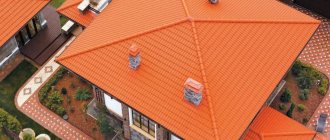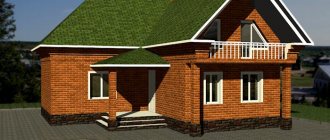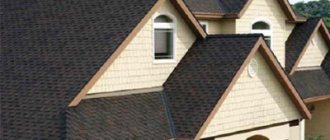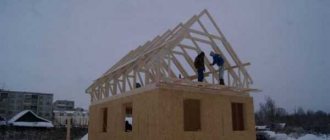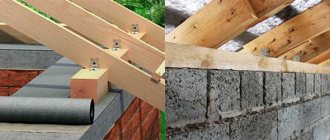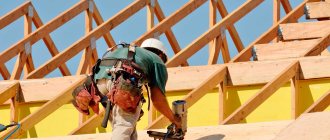Among the various roofing designs, the multi-gable roof is considered the most complex and attractive. The peculiarity of its design lies in the large number of complex elements. These include gables, gables, valleys and ribs. In this article we will tell you how to build a multi-gable roof by hand, show drawings and diagrams, photos and video materials.
Most often, a multi-gable roof is made in several cases:
- originally;
- in the process of adding premises;
- for installation of side lighting in the attic;
- in buildings with complex layouts and many rooms.
Peculiarities
Scheme of the rafter system
A simple version of the gable roof is a gable roof without gables. In this design, the upper triangular section of the wall is called a gable. There are no simple steps in the process of building a multi-gable roof; all actions, starting with calculations, require knowledge and skills. The roof structure allows for a living space to be located underneath it. Despite the difficulties, home owners undertake independent installation, which allows them to save a significant amount of money. A multi-gable roof will require enormous physical and financial costs, but will delight the creators with the architectural beauty of the building.
Design advantages:
- thanks to the balanced rafter system, the roof can easily withstand high loads;
- the roof has an original and attractive appearance;
- the design is reliable and durable;
- free space appears for an additional room or attic;
- Snow cover does not linger on steep slopes.
Flaws:
- complex design requiring competent calculations and installation;
- a large amount of waste generated when cutting roofing material, especially metal tiles;
- high load on the valley caused by snow;
- the need for high-quality waterproofing of internal joints.
Multi-gable roofs: advantages and disadvantages
So, it is logical that a multi-gable roof often crowns houses with complex configurations. It gives special expressiveness to the appearance of the house and in the classic version looks like this:
Impressive, isn't it? But architects call the roof the fifth façade for a reason. And in construction it is extremely important to maintain a balance between functionality and aesthetic preferences. After all, design solutions can be quite complex, and as a result, the rafter system receives many joints and internal valleys. And this already threatens a number of problems during construction and operation.
Let's take a closer look at this point. It is important! From time immemorial, house builders have known that the simpler the roof is in architectural terms, the more reliable and durable it is. This is why, in theory, it is right to strive to reduce the number of valleys and skate drops. On the other hand, cross-shaped, L-shaped and other similar types of roofs with several gables not only look beautiful, but also allow you to build a house that will be the most comfortable, light and functionally thoughtful.
The second point is practical. A house in the shape of the letters “G”, “P” or a cross allows you to advantageously turn your “back” to your neighbors, and “face” to the sun and a beautiful site. After all, if you think through the construction plan well, you can lure the sun’s rays into all living rooms as much as possible, make a good layout inside and, if necessary, separate an entire wing for a grumpy relative or a creative person who loves silence so much. Yes, in this case the house loses its compactness, but it becomes more thoughtful and comfortable.
Also, often another room or veranda is added to the house, and then an additional gable roof is literally built into the existing one. Its rafter system is also undergoing changes, but thanks to this, an equally important housing issue is being resolved.
Designations of main structural elements
Roofing device
The endova is the place of internal connection of the slopes; they are one of the key nodes. They have to withstand a significant load from the accumulation of snow, so support from below is provided from a system of supports and struts. Waterproofing the unit is of great importance; all the water flowing down the roof passes through the valleys. Any design error will result in a leak.
Ribs - represent the outer corner of the connected slopes. One of the most difficult places in the design of a multi-gable roof is the intersection of the ridge beam, to which the valley adjoins. A ridge is one of the ribs of the roof.
A gable is a section of a wall limited by slopes; it is shaped like a triangle and is not separated from the wall by a cornice.
Mauerlat is the load-bearing base of the entire roof, distributing the load on the walls and foundation.
Rafters - layered, hanging and diagonal.
Sheathing is a timber frame necessary for fastening roofing material and insulation.
Laying the Mauerlat
Installation of the rafter system of a low-rise building begins with laying the mauerlat. This term refers to the support beam, which is mounted on the upper frame of the load-bearing walls where the roof slope rests on them. The number of mauerlat bars involved in the design always coincides with the number of slopes. The Mauerlat is made from thick wooden beams 10-15 cm thick. The laying of this frame element is carried out in accordance with the following rules:
- The Mauerlat is installed only if the frame of the house is made of brick, concrete, gas silicate, or foam block. In wooden buildings, the role of the mauerlat is played by the upper crowns of the frame, firmly fixed with metal brackets or dowels.
- Some types of layered rafter systems do not provide for the installation of a Mauerlat, since they do not exert a bursting load on the walls of the structure.
- Strong waterproofing is always laid between the wall of the house and the mauerlat to prevent condensation from settling or rotting of the wood. For these purposes, use glassine, roofing felt or roofing felt.
- It is not allowed to make a tie-in under the rafter legs in the mauerlat, since each violation of the integrity reduces the strength of the beam.
- The Mauerlat beam is fastened using studs embedded in the wall of the house, or long anchor bolts.
Rules for installing the Mauerlat
Installation of the rafter frame
Roof rafter system
The basis of a multi-gable roof is the Mauerlat. The base element is subject to high load, so a beam with a cross section of 150x150 mm is used for it. It is attached to the walls of the building with anchors laid during the construction of the house. The rafters rest on the mauerlat. Rafters can be layered or hanging. Their choice is determined by design features.
In the case of hip and half-hip roofs, diagonal rafter legs are installed at the junction of the slopes. These elements bear the main load, so they require reinforcement by specialists. Such rafters can be made double, connected from two boards 150x50 mm. Rafter legs, reinforced with struts and crossbars, form trusses. To ensure the attractive appearance of a multi-gable roof and the necessary structural rigidity, all truss parts are made using templates. Beginning builders can assemble trusses not by cutting them, but by fastening them with overhead metal elements.
Top view of the rafter system
The rafters are attached to the mauerlat by cutting, installing brackets or corners. At the top, the rafters are connected by a ridge beam. When installing a rafter system in a large house, ceiling beams are used as tie-downs. The structure can be strengthened by a bench - a horizontal beam laid exactly in the middle between two walls and connected to the mauerlat. Additional beds can be placed under the slanted legs and valley.
Stages of the construction process
Let's move on to the section: stages of the construction process
.
For multi-tongue
Roofing on your own requires a work plan, from which it is absolutely not recommended to deviate from it. Now let's move on to the construction stages:
- Now you can proceed to laying the Mauerlat, which is fixed on the reinforced belt, and installing the rafter legs. If you plan to install a half-hip or hip roof, you need to install diagonal rafters reinforced with spigots.
- Metal brackets, plates or corners are used as fasteners for installing rafter legs on the mauerlat. It is also possible to fix these elements using technological cuts.
To install rafters, metal brackets, plates, and corners are used
- If the house has a large area, most likely it will require the installation of ceiling beams (longitudinal or transverse) that serve as tie-downs.
- First you need to take the dimensions of the house.
- After this, a vapor barrier material, sheathing and counter-lattice (ventilation system) are placed, the upper part of the rafters is attached to the ridge.
Before installing the roof, a ventilation system is installed
- Next, the cross-section of the rafters is determined and a scheme (project) for installing all roofing elements is developed.
Rafter drawing
multi-gable
roof systems - The final stage of work is the installation of roofing material (metal, bitumen, ceramic tiles, etc.).
_
Construction
– type of production activity, the result of which is construction products or construction materials and products. (SNiP 12-03-2001)
Device
– a set of elements representing a single structure (multi-contact relay, set of transistors, board, block, cabinet, mechanism, dividing panel, etc.). The device may not have a specific functional purpose in the product. (GOST 2.701-84)
Roof
– the top element of the covering that protects the building from the penetration of atmospheric precipitation. (SNiP II-26-76); – the top element of the covering that protects the building from precipitation. (VSN 35-77)
Project
– design and estimate documentation developed for a specific facility in accordance with the requirements of the Building Code for the time being. development, coordination and approval of design and estimate documentation. (SNiP 3.01.01-85)
Section
- an image of a figure obtained by mentally dissecting an object with one or more planes. The section shows only what is obtained directly in the cutting plane. (GOST 2.305-68)
Installation
– energy the conventional name of an object in power structures for which a diagram is issued, for example, main circuits. (GOST 2.701-84)
Material
– any ingredients, raw materials, components, parts, etc. used to manufacture the product.
Materials
- a collective term denoting a variety of material elements of production, used mainly as objects of labor - raw materials,
basic
and auxiliary materials, fuel, energy, purchased products and semi-finished products, work clothes, spare parts for repairs, tools and low-value and wearable items.
Installation of the valley
After installing the rafters, the sheathing is placed on them; at the joints of the slopes, where the valleys are located, it is continuous. The waterproofing scheme for the internal corner provides for laying an additional layer to ensure the reliability of the structure. Waterproofing is laid on the boards and the bottom strip is mounted. If the valley consists of several parts, they are attached from below, with the upper part covering the edge of the lower element. The junction of the bottom strip and the roofing is insulated. To give the structure a finished look, a top valley strip is installed.
Video description
Installing the Mauerlat is a responsible procedure, since it serves as a support for the rest of the structure. For a better understanding of the Mauerlat installation method, it is recommended to watch the video:
- Laying the bed. One or two beams are placed on the central axis (or on the sides of it at a calculated distance).
- The outer stands are installed at the ends of the bed. Intermediate elements are installed between them in increments of 3-6 m, if the length of the roof allows this.
- A ridge girder is strengthened on the top of the row of posts. It is fixed with metal brackets or special corners.
- The rafters are being installed. The lower part is attached to the Mauerlat, the upper part rests on the ridge with fastening to it, or is connected to the opposite rafter leg with support on the ridge girder. The installation pitch of the rafters ranges from 0.6 -1.2 m. They are evenly distributed along the entire length of the roof.
- The rafters are strengthened with struts and crossbars according to the design diagram. If the width of the slope is large enough, the number of elements can be increased.
- Laying a vapor barrier membrane. It is placed in overlapping stripes, starting from the bottom.
Laying vapor barrierSource stroytvoydom.ru
- Installation of fillies, design of eaves overhang. Lining the bottom with boards or siding.
- On top of the rafters, a continuous plank flooring or a thinner sheathing is installed. Typically, a 40 mm thick edged board is used for it.
- Roof installation. The work is carried out in accordance with the installation technology of this coating.
The assembly procedure given is valid for any type of roof. Minor adjustments are made to it to give the desired shape or configuration.
Lathing, insulation and roof installation
Installation of a roofing pie
The last element of the rafter system is the sheathing. It is pressed onto the rafters in increments depending on the choice of roofing covering. For a soft roof it is made continuous, for metal tiles - in increments of 25–30 cm. A sheet for waterproofing is laid horizontally on the sheathing, the overlap of the strips is 10 cm. If insulation is provided, the material is laid under the waterproofing. When insulating a structure, we must not forget about the ventilation holes. For a multi-gable roof, a lightweight covering is recommended so as not to create additional load on the rafters, for example, when laying metal tiles.
Multi-gable roof installation completed
There are many options for how to make a multi-gable roof; they differ in design complexity and appearance. This type of roofing looks best on square and rectangular houses.
Design nuances
Typical designs of houses with a multi-gable roof include a pitched rafter system with a slope towards the walls of the building. This makes it possible to effortlessly ensure the drainage of rain and snow removal. The structural elements that make up the roofing device are as follows:
A slope is a fragment of a roof without bends or turns; Gable (pediment) - the upper fragment of the outer wall, the boundaries of which are determined by the slopes of the roof. There is a minor difference between a gable and a gable: a gable has no cornice at the bottom; Valley (gutter) - internal corner joints of the roof that appear at the junctions of the slopes. At the end, the valley ends at the border of the pediment. The valley is the most loaded part of the roof structure, as snow and rain streams constantly collect in the inner corners (see photo above)
During construction work, it is this area that needs to be given special attention in order to avoid problems associated with leaks in the future. Rib (ridge - a horizontally located joint that is formed when connecting adjacent slopes; The overhang provides the connection of a roof fragment with a width of 300-500 mm. The main function of the overhang is to protect the building from rain and snow, the maximum possible drainage of rain and melt water; The drainage system drains water from roofing into the drainage system; The junction is a fragment of the junction of the slopes with the outer wall.
Valley roof
Pediment elements
- Skate;
- Pediment detail - wind or end batten;
- Lower valley;
- Upper valley;
- Drip edge - cornice strip;
- Snow retention bar;
- Adjacent strip;
- Ventilation shaft cover;
- Low tide on the window;
- Pediment L-strap for external roof corners;
- Soffit;
- Ventilation duct covered with corrugated sheet;
- Window in the attic;
- Wall J-channel;
- Gutter.
Elements of a multi-slope roof
Octagonal roof - photo The slope angle at which the multi-gable roof rafter system is erected and the roofing covering is laid is calculated when drawing up the project, and depends on the following parameters:
- Climatic conditions in the region;
- Roofing and other materials used;
- Architecture of the house.
The simplest solution when building a multi-gable roof is two gable planes adjacent to each other at an angle of 900 (see photo below). The top view clearly shows the cruciform shape of the roof. This design is welcome not only in a single version - you can combine several such pitched structures on the roof of one house at once. This technique is designed to construct original gable roofs that improve the design and architecture of the building.
4 stingraysIn what cases is it preferable to create roof coverings of this type?
The need to construct a complex object may arise in a number of cases:
- when the roof must be made in the same architectural style as the structure being built;
- if additional extensions were made to the main building;
- in the case when the structure of a simple rectangular or square shape is complemented by several pediments;
- if the project involves the installation of recessed balconies or windows, including dormer windows, on the roof;
- if necessary, create side lighting in the attic;
- in large multi-room buildings with a complex multi-level layout.
What it is?
The roof of a house is a multifunctional element. It simultaneously performs technical, operational and aesthetic tasks. The success of its use depends on the high-quality elaboration of all elements, and its unique appearance can make the structure especially attractive.
A traditional gable roof with two gables is called a two-gable roof. If the project provides for the presence of several elements consisting of paired pediments or gables, then it is called multi-gable. Such a structure is considered the most complex due to the presence of a large number of different architectural elements. It is they who make the roof the most attractive and original, capable of giving even the most ordinary building the image of a medieval castle.
Scheme
Multi-gable roof drawing
Creating a wireframe
Window frame on multi-gable roof
Roof structure
Multi-gable roof rafter system
Briefly about the main thing
Installation of the rafter system is the main stage of roof construction. This is a supporting structure that receives and distributes snow and wind loads, holds the roofing in a given position, and protects the walls and foundation of the house from moisture.
The rafters include many elements, each of which performs its own task. Some serve as a frame for the perimeter of the walls, others support the rafter legs, and others connect them and keep them motionless. The result is a strong, balanced structure that is light in weight. And the load-bearing capacity is very significant.
The elements of the system can be connected in several ways, which allows you to obtain different roof designs. The choice of one form or another is made at the design stage, but, if necessary, you can change the shape and configuration of individual sections or the entire roof.
It is recommended to entrust installation to experienced specialists who can perform the assembly correctly and avoid mistakes.
Calculation (angle, load, length)
The calculation of the rafter system of a gable roof is based on the fact that in the frontal dimension it has the shape of an equilateral triangle, the sides of which can be easily calculated using simple trigonometric formulas.
These simple calculations help determine the optimal distance between the rafters, their thickness and length. The design calculations are performed in the following sequence:
- Determine the design and slope of the roof. There are various ways to select the type and slope of the roofing structure. This parameter depends on the climatic conditions and performance characteristics of the selected roofing material.
- Determine the total load on the structure. To do this, sum up permanent loads (the weight of the roofing, the weight of the frame, thermal insulation and floors) with temporary loads (snow load, wind load), multiply by a correction factor that takes into account the slope of the slopes, and then add 10-15% to this figure so that the frame had some margin of safety.
- Calculate the length of the rafter legs. To do this, they use the Pythagorean theorem, because the truss is an equilateral triangle. It turns out that the square of the length of the rafter leg is equal to the sum of the squares of the height of the blood and half the length of the laying. Knowing how to calculate the length of the rafters, you can calculate the height of the ridge.
- Determine the cross section of the elements. The optimal cross-section of elements is selected from tables in accordance with the length of the rafter legs and the distance between them. The higher these indicators are, the thicker the rafters should be.
Formula for calculating the height of the ridge of a gable roof
Selection of rafter section
Load calculation
Material selection
Calculating the angle of inclination
The angle of inclination of the slopes is selected not depending on aesthetic preferences, but based on weather conditions, taking into account the roofing material. Steeper slopes of 40-45 degrees are built in areas with a lot of snow cover, and flatter slopes of 10-20 degrees in places with strong gusty winds.
Keep in mind that the steeper the slope, the higher the consumption of materials, the higher the final cost of the roof.
Be sure to take into account the requirements of the material:
- Tiles and slate require a slope of at least 22 degrees, otherwise precipitation will seep through the joints between the elements.
- Metal tiles are laid at an angle of at least 14 degrees, since they suffer greatly from gusts of wind, they can become deformed or even fly off.
- The soft roof allows an inclination angle of up to 5-10 degrees, making it possible to cover slopes of any geometry.
- Ondulin is considered one of the most reliable materials and can be used even for roofs with a slope of less than 6 degrees.
- Corrugated sheets cannot be laid at an angle of less than 15 degrees, however, it is advisable to treat slopes even with an acceptable slope with sealant for better waterproofing.
The angle of inclination of the slopes of a gable roof
How to choose: what to consider?
The rafter system must be selected as correctly and clearly as possible.
When looking for a suitable solution, you need to pay attention to the following points:
- strength;
- the ability to support slopes and the roof as a whole of a certain size and geometry;
- creating a positive aesthetic image of the building as a whole.
Technical parameters have priority. Even the most beautiful structures that comply with design principles will not show their positive qualities if they last too little. Experienced builders always analyze average annual and seasonal temperatures, the financial capabilities of developers, the maximum possible wind speed and the severity of the overlying roof
The future use of the under-roof space and the scale required for it are also taken into account. Wind, snow and rain cannot be underestimated, since these factors can have a very strong impact on the roof, and through it on the rafters
You can avoid mistakes if you look at houses that have already been built nearby and have been in use for a long time. By accurately reproducing the design of their roof and the rafter system interconnected with it, it is possible to best take into account local specifics. But not everyone follows this path; sometimes the task is to develop an exclusively original project. Then you will have to carefully collect initial data and carry out scrupulous calculations. In the absence of special knowledge, it is better to attract qualified performers to help.
Having analyzed the total load created by wind and snow, you can sometimes find that certain parts of the rafter complex need selective reinforcement
When assessing the required angle of inclination of the roof, attention is also paid to the type of coating used. Heavy metal tiles or corrugated sheets with a very large slope can spontaneously slide down, you have to additionally fasten them, complicating your work and increasing the cost of installation
In addition, certain materials tend to retain water or become saturated with it; this can only be combated by making the slope steeper. Creating a good roof and rafter system that satisfies such conflicting requirements is not always accessible to non-specialists.
Brief step-by-step instructions for construction
Installation of a multi-gable structure must be carried out in strict accordance with the design documentation.
All work is carried out in stages.
- Climatic data that is typical for the region of the facility under construction is collected. This information is taken into account when carrying out technical calculations and developing the project.
- Object design and calculations. It is better to entrust a thorough preliminary calculation of all components of the roof to experienced specialists. In addition, it is necessary to determine in advance the types and volumes of materials that will be used in construction.
- A Mauerlat is laid around the perimeter of the building.
- Vertical support posts are installed and horizontal beams are mounted - purlins that form the ridge.
- Installation of main and additional supports forming the transitions of the planes.
- The posts and rafters are reinforced with rafter legs or struts. They help distribute the load evenly and also prevent structures from sagging.
- The elements are connected using metal fasteners - plates, brackets, threaded rods or anchors. To strengthen the connection of the boards, wooden bosses are used.
- On top (along the rafters) lathing in the form of horizontal strips is laid.
Waterproofing and protecting attics from heat loss
Roll waterproofing is laid in overlapping strips and perpendicular to the direction of the roof slope. An overlap of at least 15 cm in width must be made. The joints of the strips are glued together using a special adhesive tape or construction tape
Particular attention is paid to valleys, as they receive the largest amount of rain or melt water, and therefore are the most vulnerable place
It should be noted that traditional waterproofing products in the form of roofing felt or glassine can no longer provide long service life and strength. They do not fully comply with modern standards of environmental cleanliness and safety. Therefore, membrane materials are becoming increasingly widespread. In addition to their main function, they are able to significantly reduce heat loss by increasing the thickness of the insulation to the full height of the rafters.
The construction of a multi-gable roof involves the formation of an attic space spacious enough to accommodate residential or utility rooms. Therefore, the roof must be well insulated and insulated from excess moisture entering it. Insulation based on mineral wool is ideal for this. They prevent the appearance of “cold zones” where condensation can form. Among the features, it is worth noting the particularly soft structure, which allows the use of this material in hard-to-reach areas.
For the production of mineral insulation, glass or basalt is used. Their undoubted advantage is the simultaneous combination of the following properties:
- ease;
- fire resistance;
- environmental friendliness.
In addition to all of the above, this type of building material is distinguished by a high degree of sound absorption and sound insulation, which is especially important during heavy rain or hail.

